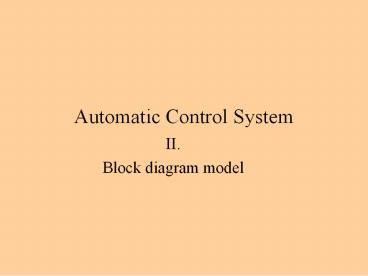Automatic Control System PowerPoint PPT Presentation
1 / 21
Title: Automatic Control System
1
Automatic Control System
- II.
- Block diagram model
2
Modelling dynamical systems
- Engineers use models which are based upon
mathematical relationships between two variables.
- We can define the mathematical equations
- Measuring the responses of the built process
(black model) - Using the basic physical principles (grey model).
In order to simplification of mathematical model
the small effects are neglected and idealised
relationships are assumed. - Developing a new technology or a new construction
nowadays its very helpful applying computer
aided simulation technique. - This technique is very cost effective, because
one can create a model from the physical
principles without building of process.
3
LTI (Linear Time Invariant) model
- The all physical system are non-linear and their
parameters change during a long time. - The engineers in practice use the
superpositions method.
x(t)
y(t)
x(j?)
y(j?)
First One defines the input and output signal
range. In this range if an arbitrary input signal
energize the block and the superposition is
satisfied and the error smaller than a specified
error, than the block is linear.
4
The steady-state characteristics and the dynamic
behavior
100
y(t)
WP2
WP1
t
x(t)
0
100
0
t
The steady-state characteristic. When the
transients signals have died a new working point
WP2 is defined in the steady-state
characteristic.
The dynamic behavior is describe by differential
equation or transfer function in frequency domain.
5
Transfer function in frequency domain
- Amplitude gain
- Phase shift
6
The graphical representation of transfer function
- The M-a curves The amplitude gain M(?) in the
frequency domain. In the previous page M(?) was
signed, like A(?) The phase shift a(?) in the
frequency domain. In the previous page a(?) was
signed, like f(?)! - A Nyquist diagram The transfer function G(j?)
is shown on the complex plane. - A Bode diagram Based on the M-a curves. The
frequency is in logaritmic scale and instead of
A(?) amplitude gain is
- A Nichols diagram The horizontal axis is f(?)
phase shift and the vertical axis is The a(?) dB.
7
The basic transfer function
In the frequency domain is the transfer function
In the time domain is the differential equitation
8
Block representation
Actuating path of signals and variables
One input and one output block represents the
context between the the output and input signals
or variables in time or frequency domain
Summing junction
Take-off point (The same signal actuate both path)
9
P proportional
t
- Step response Bode diagram
10
I Integral
- Step response Bode diagram
11
D differential
The step response is an Dirac delta, which isnt
shown
- Step response Bode diagram
12
PT1 first order system
- Step response Bode diagram
13
PT2 second order system
- Step response Bode diagram
14
PH delay
- Step response Bode diagram
15
IT1 integral and first order in cascade
- Step response Bode diagram
16
DT1 differential and first order in cascade
- Step response Bode diagram
17
PI proportional and integral in parallel
- Step response Bode diagram
18
PDT1
- Step response Bode diagram
19
Terms of feedback control
plant
controller
controlled variable
compensator or control task
transmitter
manipulated variable
error signal
actuator
comparing element or error detector
disturbance variable
reference signal
feedback signal
reference input element
block model of the plant
action signal
20
Block diagram manipulation
G1
G1G2
G1
G1
G2
G1
G2
G1
G1
G1
G1
21
Block diagram reduction example
G4
G5
G7
G1
G3
G2
G6

